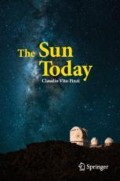Abstract
Stars have long been classified on the basis of their brightness; variability was a secondary consideration but eventually proved an important clue to stellar dynamics as well as a means of classification. The Sun’s ~11-year activity cycle, identified mainly from sunspots and other surface features, is superimposed on both longer and shorter periodicities which are manifested in luminosity and internal processes to different degrees. Solar observation thus makes increasing demands on the versatility and sensitivity of observatories, observers and their archives, and rules out an all-purpose definition of the present-day Sun.
Access this chapter
Tax calculation will be finalised at checkout
Purchases are for personal use only
References
Abbott CG, Fowle FE Jr (1908) Recent determination of the solar constant of radiation. Jour Geophys Res 13:79–82
Ackermann M et al (2014) High-energy gamma-ray emission from solar flares: summary of FERMI Large Area Telescope detections and analysis of two M-class flares. Astrophys J 787:15
Albrect R, Maitzen HM, Rakos KD (1969) The Sun as a Variable Star. Astron Astrophys 3: 236–242
AAVSO (American As Variable Star Observers) (2017) www.aavso.or
Bastian T (2004) Low-frequency solar radiophysics with LOFAR and FASR. Planet Space Sci 52:1381–1389
Bradaschia F (2013) Radioastronomy. Sandit
Cessateur G et al (2016) Total Solar Irradiance changes between 2010 and 2014 from the PREcision MOnitor Sensor absolute radiometer (PREMOS/PICARD). AGU Fall Ass 2016, Abs SH42B
Domingo V (1994) In Pap JM et al (eds) The Sun as a variable star, IAU Colloq 143, Cambridge Univ P, Cambridge
Dudok de Wit T et al (2017) Methodology to create a new total solar irradiance record. Geophys Res Lett 44: 1196–1203 https://doi.org/10.1002/2016gl071866
Dufresne J-L (2008) La détermination de la constante solaire par Claude Pouillet. Météo 60:36–43
Frieman EA et al (ed) (1994) Solar influences on global change. Nat Acad Press, Washington DC
Fröhlich C (2016) Irradiance observations of the Sun. Intern Astron Un Colloq 143: 28–36
Fröhlich C & Anklin M (2000) Uncertainty of total solar irradiance: an assessment of the last twenty years of space radiometry. Metrologia 37:387–392
Fröhlich C & Lean J (1998) Total solar irradiance variations: The construction of a composite and its comparison with models. Proc Int Astr Un 185:89–102
Hilbig T et al (2016)The new SCIAMACHY reference solar spectral irradiance and its validation. Geophys Res Abs 18
Kalisz J (2004) Review of methods for time interval measurements with picosecond resolution. Metrologia 41:17–32
Kepler SO et al (2000) Evolutionary timescale of the pulsating white dwarf G117-B15A: the most stable optical clock known. Astrophys Jour 534: L185–L188
Kopp G, Lean JL (2011) A new, lower value of total solar irradiance: Evidence and climate significance. Geophys Res Lett 38: L01706, https://doi.org/10.1029/2010gl04577
Krivova NA, Solanki SK, Wenzler T (2009) ACRIM-gap and total solar irradiance revisited: is there a secular trend between 1986 and 1996? arXiv:0911.3817v1[astro-ph.SR]
Krivova NA, Solanki SK (2013) Models of solar total and spectral irradiance variability of relevance for climate studies, in Lübken F-J (ed) (2013) Climate and weather of the Sun-Earth system (CAWSES). Springer, 19–38
Kurucz RL (1991) The solar spectrum. In: Cox AN, Livingston WC, Matthews MS (eds) Solar interior and atmosphere. Univ Arizona Press, Tucson AZ, 663–669
Kuzhevskii BM (1982) Gamma astronomy of the Sun and study of solar cosmic rays. Soviet Phys Uspekhi 25:392–408
Langley SP (1884) Researches on solar heat and its absorption by the Earth’s atmosphere. Rep Mount Whitney Exped, Prof Pap Signal Serv15. Washington
Lean J (2000) Evolution of the Sun’s spectral irradiance since the Maunder Minimum. Geophys Res Lett 27:2425–2428
Lemen JR et al (2012) The Atmospheric Imaging Assembly (AIA) on the Solar Dynamics Observatory (SDO). Sol Phys 275:17–40
Lockwood GW, Skiff BA, Baliunas SL, Radick RR (1992) Long-term solar brightness changes estimated from a survey of Sun-like stars. Nature 360:653–655
Mäkelä P et al (2015) Estimating the height of CMEs associated with a major SEP event at the onset of the metric type II radio burst during solar cycles 23 and 24. Astrophys J 806:13
Meftah M et al (2017) SOLAR-ISS: a new reference spectrum based on SOLAR/SOLSPEC observations. Astron Astrophys doi.org/https://doi.org/10.1051/0004-6361/201731316
NASA (2017) www.mynasadata.larc.nasa.gov/
Needham J (1959) Science and civilisation in China, 3: Cambridge Univ Press, Cambridge
Østgaard N et al (2003) Neutral hydrogen density profiles derived from geocoronal imaging. J Geophys Res 108:A7s
Rottman GJ, Woods TN, McClintock W (2006) SORCE solar UV irradiance results. Adv Space Res 37:201–208
Southworth GC (1945) Microwave radiation from the Sun. J Frank Inst 239:285
Willson RC (1984) Measurements of solar total irradiance and its variability. Space Sci Rev 38: 203–242
Yeo KL, Krivova NA, Solanki SN (2017) EMPIRE: A robust empirical reconstruction of solar irradiance variability. arXiv: 1704.07652v1 [astro.ph.SR]
Author information
Authors and Affiliations
Corresponding author
Rights and permissions
Copyright information
© 2018 Springer Nature Switzerland AG
About this chapter
Cite this chapter
Vita-Finzi, C. (2018). An Inconstant Star. In: The Sun Today. Springer, Cham. https://doi.org/10.1007/978-3-030-04079-6_2
Download citation
DOI: https://doi.org/10.1007/978-3-030-04079-6_2
Published:
Publisher Name: Springer, Cham
Print ISBN: 978-3-030-04078-9
Online ISBN: 978-3-030-04079-6
eBook Packages: Physics and AstronomyPhysics and Astronomy (R0)

